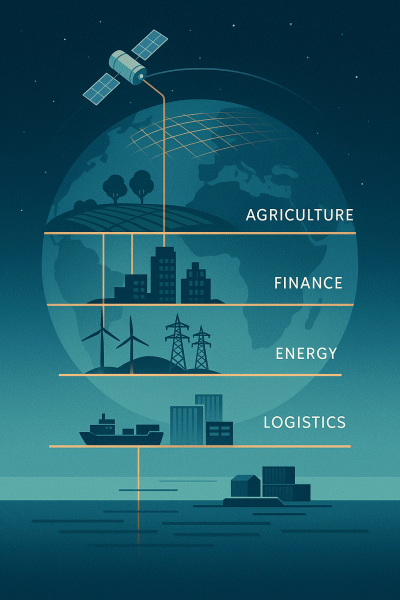By Tamara Bond-Williams, Executive Director
 The past few years have seen a surge in space and satellite activity from corners of the world rarely focused in industry coverage. But this isn’t just expansion. It’s transformation. The business of space is no longer defined by a few vertical integrators and legacy launch corridors. It's being reshaped by regional markets, commercial infrastructure, local partnerships, and – most critically – by talent.
The past few years have seen a surge in space and satellite activity from corners of the world rarely focused in industry coverage. But this isn’t just expansion. It’s transformation. The business of space is no longer defined by a few vertical integrators and legacy launch corridors. It's being reshaped by regional markets, commercial infrastructure, local partnerships, and – most critically – by talent.
The articles assembled for this issue are proof points of market formation: how space businesses emerge, where they take root, and what conditions turn policy into platforms and vision into viable service.
 This issue concludes a news aggregation and podcast series made possible by the support of ST Engineering iDirect. Over the past year, the series has explored how and where space business is evolving – in orbit, on the ground, and in between. We’re not just curious about where the space and satellite business is happening, but how it’s happening. For instance, in Canada, it’s emerging from a new approach to access and scalability. In Africa, we see a mix of public investment, commercial readiness, and the sheer persistence of early-stage entrepreneurs. In the Middle East, governments are actively building talent pipelines to support business competitiveness and regional autonomy. In Asia, market demand is forcing commercial players to adapt – and thrive – at scale. These aren’t case studies. They’re signals.
This issue concludes a news aggregation and podcast series made possible by the support of ST Engineering iDirect. Over the past year, the series has explored how and where space business is evolving – in orbit, on the ground, and in between. We’re not just curious about where the space and satellite business is happening, but how it’s happening. For instance, in Canada, it’s emerging from a new approach to access and scalability. In Africa, we see a mix of public investment, commercial readiness, and the sheer persistence of early-stage entrepreneurs. In the Middle East, governments are actively building talent pipelines to support business competitiveness and regional autonomy. In Asia, market demand is forcing commercial players to adapt – and thrive – at scale. These aren’t case studies. They’re signals.
And they tell us something simple: space business emerges where local demand, infrastructure, and execution align – where services become viable, revenue-generating, and responsive to markets on the ground.
 One region's path will not look like another's. The most promising space economies aren’t copying each other. They’re designing for fit: aligning commercial models with local constraints and capabilities. That’s where the opportunity lies: in developing space capabilities that grow out of local needs – and then feed back into local opportunity.
One region's path will not look like another's. The most promising space economies aren’t copying each other. They’re designing for fit: aligning commercial models with local constraints and capabilities. That’s where the opportunity lies: in developing space capabilities that grow out of local needs – and then feed back into local opportunity.
As we track that growth, we should be clear-eyed. Space business doesn’t just follow vision. It follows capital. It follows demand. It follows the ability to manage risk and deliver returns. That’s why wealth still matters – not as a moral question, but as a business one. Viable space economies depend not just on access, but on the infrastructure and financial runway to stand up enduring services.
The central insight may be this: space is no longer a sector – it’s a layer. In the most advanced economies, it is increasingly hard to separate satellite applications from agriculture, finance, energy, logistics, or defense. In emerging markets, it is sometimes being built from the outside in – often through connectivity and Earth observation – but it is always being adapted for local value. As these systems root themselves, the return is not only technical – it is economic. New revenue. New careers. New ecosystems.
That brings us to talent
In this industry, talent doesn’t just power business – it is the business. Talent is how services get built, adapted, maintained, and monetized. It’s how global companies scale across geographies and how local companies scale across product lines. Talent is what turns a startup cluster into a value chain. And in every article in this issue, you’ll see that what’s being cultivated – often quietly, often against the odds – is not just skill, but capacity. The ability to deliver. That’s business development.
 We at SSPI are privileged to witness this evolution and to have had one of the industry’s great chroniclers capturing it as it unfolded. With this issue, we conclude the podcast series hosted by Lou Zacharilla (pictured left) and supported by ST Engineering iDirect. The series, and now this expanded editorial companion, offers a sharper view of the business of space – not as a collection of technologies – but as an emergent network of companies, competencies, and customers around the globe.
We at SSPI are privileged to witness this evolution and to have had one of the industry’s great chroniclers capturing it as it unfolded. With this issue, we conclude the podcast series hosted by Lou Zacharilla (pictured left) and supported by ST Engineering iDirect. The series, and now this expanded editorial companion, offers a sharper view of the business of space – not as a collection of technologies – but as an emergent network of companies, competencies, and customers around the globe.
Lou’s voice has shaped this narrative from the beginning – not just as a host, but as a mentor to a generation of professionals. He helped us see that what matters in this industry is not just how high we fly, but what – and who – we build along the way. As he steps into a new role as advisor and advocate, we thank him for that voice, and for the humanity and perspective behind it.
We’re also grateful to ST Engineering iDirect for sponsoring the full podcast series and this issue. Their support has helped us tell a deeper story: one rooted in real business, real momentum, and real people.
The space business is everywhere. And in these pages, you’ll see just how it’s getting built.

